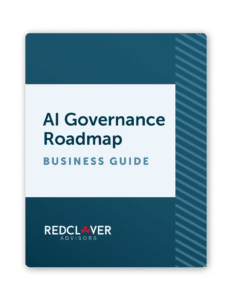Imagine driving your car without your rearview mirror, side view mirrors, or backup cameras. Technically, the car is still drivable. You could, in theory, get out onto the highway, drive at 70 MPH, reach your destination, and even parallel park in rush hour traffic.
You could. It’s possible.
But with that many blind spots, you’re risking your vehicle, your safety, and everyone else on the road, including cyclists, pedestrians, and your insurance premiums.
Just because you can do something doesn’t mean it’s a good idea.
That’s the current state of AI governance in most organizations: lots of horsepower, minimal visibility. AI tools are being deployed at high speeds without the critical privacy and compliance frameworks needed to steer safely.
Rather than opening yourself up to serious legal, reputational, and operational collisions, use AI governance to minimize those pesky blind spots and move your business forward at top speed.
What is AI governance, anyway?
Think of AI governance as your organization’s traffic laws, inspection system, and dashboard. It’s the collection of policies, procedures, and guardrails that ensure your AI systems are safe, compliant, and ethically tuned, no matter who’s driving.
At its core, governance gives organizations visibility across the entire AI lifecycle:
- How is data collected and used to train the model?
- Who approves or monitors outputs?
- What risks (bias, misuse, regulatory noncompliance) are mitigated in real time?
Without that visibility, even well-intentioned AI can cause privacy violations, discriminatory outcomes, or regulatory fines.
Don’t take our word for it: an ongoing MIT project has catalogued more than 1,600 risks ranging from data privacy violations to discrimination.
How do AI governance and data privacy intersect
AI systems don’t work without data, and a lot of that data is personal. Whether using AI for customer support, hiring, marketing, or fraud detection, the models rely on user behavior, demographics, biometric identifiers, and location data.
That’s why AI governance and data privacy aren’t two separate lanes but a shared highway. But many companies continue to approach them with siloed teams and disconnected frameworks.
Here’s the thing: governance without embedded privacy is incomplete. Organizations that fail to integrate privacy teams into AI decision-making are far more likely to mismanage sensitive data, violate consent requirements, or struggle with data subject access requests down the line.
The AI governance gaps that could put your business at risk
Artificial intelligence is a road full of cultural, legal, and organizational potholes. Here are four major buckets to consider as you move forward with AI tools and technologies.
1. Regulatory complexity may mean you have to adjust your speed.
Navigating AI regulations is like driving cross-country with MapQuest instructions from 2005. Every jurisdiction sets its rules, and new laws pop up yearly.
The EU AI Act classifies systems by risk level and imposes stricter obligations on “high-risk” tools like biometric identification or credit scoring.
In the U.S., there’s no comprehensive AI law yet. But states like Colorado, Oregon, and Texas are stepping in with their own guidance.
And if your company operates in multiple states or countries, you can’t rely on a one-size-fits-all compliance strategy. You’ll need an agile governance plan that uses industry best practices and can adapt based on regional variations.
2. Structural governance gaps: no one at the wheel
In most companies, the question of “who owns AI risk?” is still up for debate. An IBM survey shows that fewer than 30% of executives believe the AI compliance risks have been sufficiently addressed within their organization.
Lack of ownership leads to critical oversight vacuums. Without a centralized governance function, privacy teams, security officers, and AI developers are left swerving across lanes with no clear right of way.
It may be tempting to assume a system of informal or ad-hoc governance (“we’ll cross that bridge when we come to it”), but a structured governance system is the best tool to build a proactive AI governance system that is effective, while also benefiting your business via privacy by design principles.
Keep in mind that across industries:
- Only 28% of companies have dedicated data ethics teams.
- According to Deloitte, privacy-focused roles are often understaffed, and senior managers are not adequately involved in discussions on privacy compliance.
The result? Many teams are building AI business models, but these models may be at risk of compliance violations (or even systemic inefficiency).
3. Operational blind spots: shadow AI
Even if you’ve locked down official AI use, your employees may be deploying tools under the radar to do things like summarize reports, draft emails, and review documents with the vague instruction of “make this better.”
This is shadow AI: the unsanctioned use of an AI tool or application without formal approval or oversight.
Considering that 68% of organisations have experienced data leaks linked to AI tools, shadow AI is a huge blind spot for companies.
Especially when the vast majority of data privacy and data security breaches occur because of human error, it’s essential to minimize shadow AI use while providing helpful and realistic avenues for employees to request and demonstrate AI use cases internally.
4. Minimizing vendor risk
While many companies have some third-party risk management, outdated strategies may not account for the possibility of ever-evolving AI tools.
According to IBM, 20% of data breaches are linked to third parties. If your vendor risk checklist hasn’t been updated in the last two years, it’s time to take another look. If you don’t know where to start, a third-party expert can help your company build sustainable vendor risk management systems that include AI governance statutes.
AI Governance Roadmap: Business Guide
Our AI Governance Roadmap guides you to success in developing an AI governance program.

The good news: good governance is a major competitive advantage
It’s easy to think of governance as the brakes on your company’s innovation. But in reality, it’s more like having 4WD on six inches of snow: It is necessary to drive safely, and it is much easier to reach your destination.
Companies that are transparent in their operations, from AI use to data privacy, are much more likely to gain consumer trust, leading to increased customer retention, referrals, and repeat sales. That competitive edge can make all the difference in a competitive online ecosystem.
Red Clover Advisors is your privacy co-pilot
This post covered the “why.” If you’re ready for the “how,” check out our guide on building an AI governance program or evaluating AI tools with privacy in mind.
The truth is that most companies are driving full speed into AI with way too many blind spots. That’s where we come in as your privacy co-pilot.
Red Clover Advisors helps businesses build AI governance programs that improve privacy visibility. Whether you need to create policies, train your teams, set up workflows, or conduct program assessments, we help you build the infrastructure that keeps AI use safe, compliant, and in line with your business goals.
Have questions? We’re here to help. Contact us to learn how our team can take your business to the next level.


